Entrepreneurship and Small Business Management: A Comprehensive Guide
VerifiedAdded on 2024/06/28
|18
|4768
|249
AI Summary
This comprehensive guide explores the multifaceted world of entrepreneurship and small business management. It delves into various types of entrepreneurial ventures, examining their similarities and differences. The guide also analyzes the impact of micro and small businesses on the UK economy, particularly in the context of Brexit. Furthermore, it investigates the characteristics, traits, and skills of successful entrepreneurs, highlighting how background and experience can influence entrepreneurial success. This guide provides valuable insights for aspiring entrepreneurs and those seeking to understand the dynamics of small business growth.
Contribute Materials
Your contribution can guide someone’s learning journey. Share your
documents today.
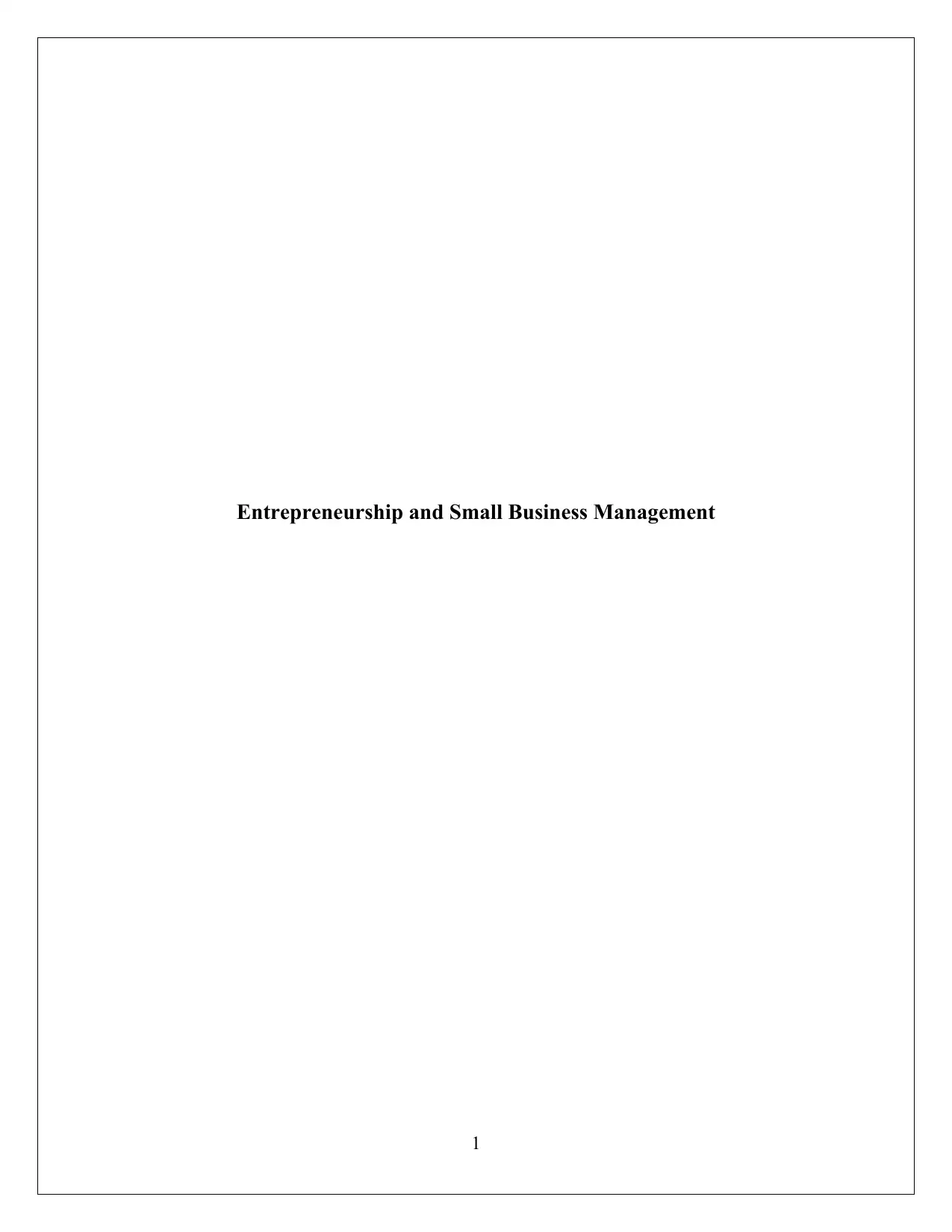
Entrepreneurship and Small Business Management
1
1
Secure Best Marks with AI Grader
Need help grading? Try our AI Grader for instant feedback on your assignments.
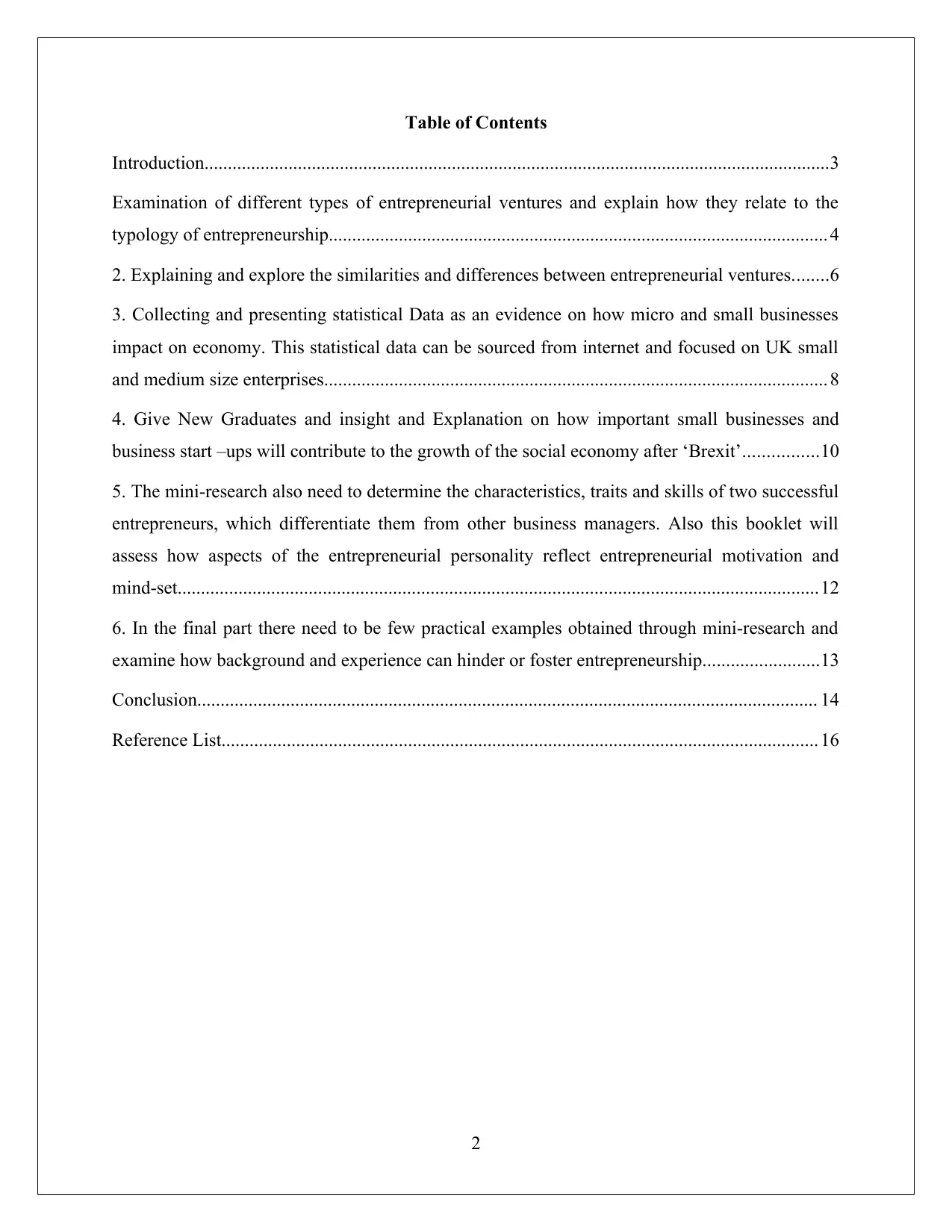
Table of Contents
Introduction......................................................................................................................................3
Examination of different types of entrepreneurial ventures and explain how they relate to the
typology of entrepreneurship........................................................................................................... 4
2. Explaining and explore the similarities and differences between entrepreneurial ventures........6
3. Collecting and presenting statistical Data as an evidence on how micro and small businesses
impact on economy. This statistical data can be sourced from internet and focused on UK small
and medium size enterprises............................................................................................................ 8
4. Give New Graduates and insight and Explanation on how important small businesses and
business start –ups will contribute to the growth of the social economy after ‘Brexit’................10
5. The mini-research also need to determine the characteristics, traits and skills of two successful
entrepreneurs, which differentiate them from other business managers. Also this booklet will
assess how aspects of the entrepreneurial personality reflect entrepreneurial motivation and
mind-set.........................................................................................................................................12
6. In the final part there need to be few practical examples obtained through mini-research and
examine how background and experience can hinder or foster entrepreneurship.........................13
Conclusion..................................................................................................................................... 14
Reference List................................................................................................................................ 16
2
Introduction......................................................................................................................................3
Examination of different types of entrepreneurial ventures and explain how they relate to the
typology of entrepreneurship........................................................................................................... 4
2. Explaining and explore the similarities and differences between entrepreneurial ventures........6
3. Collecting and presenting statistical Data as an evidence on how micro and small businesses
impact on economy. This statistical data can be sourced from internet and focused on UK small
and medium size enterprises............................................................................................................ 8
4. Give New Graduates and insight and Explanation on how important small businesses and
business start –ups will contribute to the growth of the social economy after ‘Brexit’................10
5. The mini-research also need to determine the characteristics, traits and skills of two successful
entrepreneurs, which differentiate them from other business managers. Also this booklet will
assess how aspects of the entrepreneurial personality reflect entrepreneurial motivation and
mind-set.........................................................................................................................................12
6. In the final part there need to be few practical examples obtained through mini-research and
examine how background and experience can hinder or foster entrepreneurship.........................13
Conclusion..................................................................................................................................... 14
Reference List................................................................................................................................ 16
2

Introduction
Entrepreneurship is the skill or ability to give shape to an idea and to make business out of it.
Entrepreneurship is the eagerness of an individual to run a business and to make profit out of the
actions that are made by their business. While designing a business, an entrepreneur must keep in
mind the risks t are related to the business process and the motive of the entrepreneur must be
such that all the risks are mitigated and profits are made. Small and medium sized businesses are
increasing at a faster pace and this is creating a huge impact in the economy of UK. In this
assignment, various venture types are discussed. Various impacts of entrepreneur’s mindset and
personality over the business and its decision-making are even documented in this assignment.
The information booklet to be prepared on behalf of Joe Woods would contain information
regarding the growth of entrepreneurial ventures and the factors contributing towards it.
3
Entrepreneurship is the skill or ability to give shape to an idea and to make business out of it.
Entrepreneurship is the eagerness of an individual to run a business and to make profit out of the
actions that are made by their business. While designing a business, an entrepreneur must keep in
mind the risks t are related to the business process and the motive of the entrepreneur must be
such that all the risks are mitigated and profits are made. Small and medium sized businesses are
increasing at a faster pace and this is creating a huge impact in the economy of UK. In this
assignment, various venture types are discussed. Various impacts of entrepreneur’s mindset and
personality over the business and its decision-making are even documented in this assignment.
The information booklet to be prepared on behalf of Joe Woods would contain information
regarding the growth of entrepreneurial ventures and the factors contributing towards it.
3
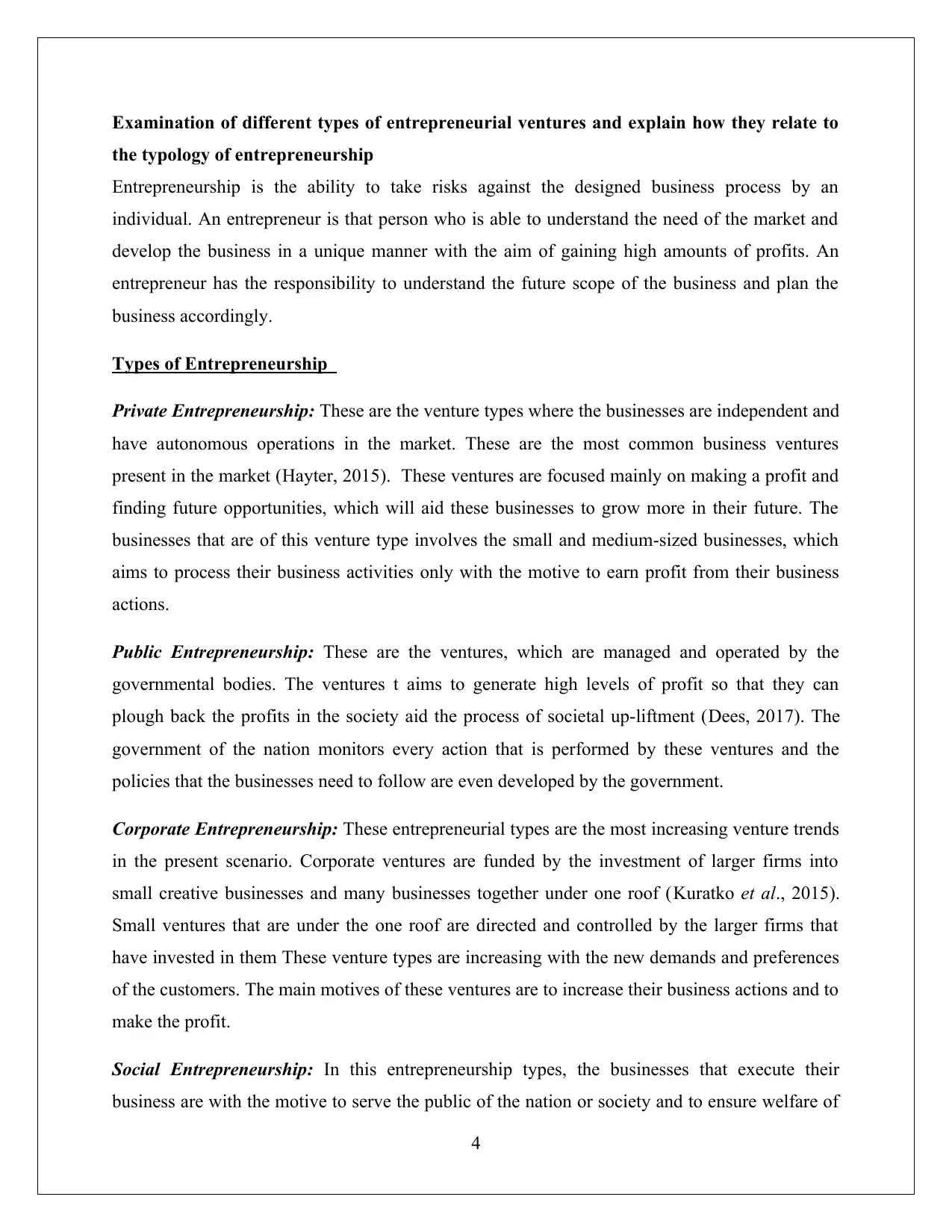
Examination of different types of entrepreneurial ventures and explain how they relate to
the typology of entrepreneurship
Entrepreneurship is the ability to take risks against the designed business process by an
individual. An entrepreneur is that person who is able to understand the need of the market and
develop the business in a unique manner with the aim of gaining high amounts of profits. An
entrepreneur has the responsibility to understand the future scope of the business and plan the
business accordingly.
Types of Entrepreneurship
Private Entrepreneurship: These are the venture types where the businesses are independent and
have autonomous operations in the market. These are the most common business ventures
present in the market (Hayter, 2015). These ventures are focused mainly on making a profit and
finding future opportunities, which will aid these businesses to grow more in their future. The
businesses that are of this venture type involves the small and medium-sized businesses, which
aims to process their business activities only with the motive to earn profit from their business
actions.
Public Entrepreneurship: These are the ventures, which are managed and operated by the
governmental bodies. The ventures t aims to generate high levels of profit so that they can
plough back the profits in the society aid the process of societal up-liftment (Dees, 2017). The
government of the nation monitors every action that is performed by these ventures and the
policies that the businesses need to follow are even developed by the government.
Corporate Entrepreneurship: These entrepreneurial types are the most increasing venture trends
in the present scenario. Corporate ventures are funded by the investment of larger firms into
small creative businesses and many businesses together under one roof (Kuratko et al., 2015).
Small ventures that are under the one roof are directed and controlled by the larger firms that
have invested in them These venture types are increasing with the new demands and preferences
of the customers. The main motives of these ventures are to increase their business actions and to
make the profit.
Social Entrepreneurship: In this entrepreneurship types, the businesses that execute their
business are with the motive to serve the public of the nation or society and to ensure welfare of
4
the typology of entrepreneurship
Entrepreneurship is the ability to take risks against the designed business process by an
individual. An entrepreneur is that person who is able to understand the need of the market and
develop the business in a unique manner with the aim of gaining high amounts of profits. An
entrepreneur has the responsibility to understand the future scope of the business and plan the
business accordingly.
Types of Entrepreneurship
Private Entrepreneurship: These are the venture types where the businesses are independent and
have autonomous operations in the market. These are the most common business ventures
present in the market (Hayter, 2015). These ventures are focused mainly on making a profit and
finding future opportunities, which will aid these businesses to grow more in their future. The
businesses that are of this venture type involves the small and medium-sized businesses, which
aims to process their business activities only with the motive to earn profit from their business
actions.
Public Entrepreneurship: These are the ventures, which are managed and operated by the
governmental bodies. The ventures t aims to generate high levels of profit so that they can
plough back the profits in the society aid the process of societal up-liftment (Dees, 2017). The
government of the nation monitors every action that is performed by these ventures and the
policies that the businesses need to follow are even developed by the government.
Corporate Entrepreneurship: These entrepreneurial types are the most increasing venture trends
in the present scenario. Corporate ventures are funded by the investment of larger firms into
small creative businesses and many businesses together under one roof (Kuratko et al., 2015).
Small ventures that are under the one roof are directed and controlled by the larger firms that
have invested in them These venture types are increasing with the new demands and preferences
of the customers. The main motives of these ventures are to increase their business actions and to
make the profit.
Social Entrepreneurship: In this entrepreneurship types, the businesses that execute their
business are with the motive to serve the public of the nation or society and to ensure welfare of
4
Secure Best Marks with AI Grader
Need help grading? Try our AI Grader for instant feedback on your assignments.

the society (Chell, et al., 2016). Organizations that are in this venture type do not execute their
business with the motive to earn profit but to solve a particular issue that the society is facing.
Academic Entrepreneurship: Various research and academic institutions initiate this
entrepreneurship types in order to develop new technology or products with the motive of
commercialization in the market. The businesses that are in this venture type are with the aim to
invent or develop newer products in the market in order to serve the citizen of a society and to
make the profit from those inventions (Wright, 2014). The only focus of these businesses is to
restore their intellectual property in order to commercialize their inventions.
Types of entrepreneurial ventures
Lifestyle ventures: These ventures are the businesses that provide stable income to the owner
and operate with the motive to sustain the lifestyle of the entrepreneur and even of the customers
by offering the basic daily life commodities (Hammond et al., 2016). The motive of these
ventures is to perform small business actions and to earn profit out of it. Such ventures have no
motive to grow while executing their business activities. These businesses execute their business
actions with plan for five minimum years.
Survival Ventures: Organizations that are under this venture category executes their businesses
with the motive to provide the fundamental elements of survival. These vesture types have
minimum assets in their organization and process their business activities in order to grow their
business in the market (Morris et al., 2018). Organization of this kind does not involve much
bank interference.
Managed growth ventures: These venture types are the most stable ventures available in the
market and design their business in the most structured manner, which helps the entrepreneurs to
make stable execution of their business activities. Organizations that are under this venture types
are with the mindset to penetrate a market with newly developed product or services and these
organizations even grow their business by increasing their employee strength (Morris et al.,
2015).
Aggressive Ventures: Organization of this venture types are mainly based on technology and are
aided with exponential growth (Morris et al., 2018). The organizations of this venture type have
5
business with the motive to earn profit but to solve a particular issue that the society is facing.
Academic Entrepreneurship: Various research and academic institutions initiate this
entrepreneurship types in order to develop new technology or products with the motive of
commercialization in the market. The businesses that are in this venture type are with the aim to
invent or develop newer products in the market in order to serve the citizen of a society and to
make the profit from those inventions (Wright, 2014). The only focus of these businesses is to
restore their intellectual property in order to commercialize their inventions.
Types of entrepreneurial ventures
Lifestyle ventures: These ventures are the businesses that provide stable income to the owner
and operate with the motive to sustain the lifestyle of the entrepreneur and even of the customers
by offering the basic daily life commodities (Hammond et al., 2016). The motive of these
ventures is to perform small business actions and to earn profit out of it. Such ventures have no
motive to grow while executing their business activities. These businesses execute their business
actions with plan for five minimum years.
Survival Ventures: Organizations that are under this venture category executes their businesses
with the motive to provide the fundamental elements of survival. These vesture types have
minimum assets in their organization and process their business activities in order to grow their
business in the market (Morris et al., 2018). Organization of this kind does not involve much
bank interference.
Managed growth ventures: These venture types are the most stable ventures available in the
market and design their business in the most structured manner, which helps the entrepreneurs to
make stable execution of their business activities. Organizations that are under this venture types
are with the mindset to penetrate a market with newly developed product or services and these
organizations even grow their business by increasing their employee strength (Morris et al.,
2015).
Aggressive Ventures: Organization of this venture types are mainly based on technology and are
aided with exponential growth (Morris et al., 2018). The organizations of this venture type have
5

higher capability to improve their developmental process in order to make their business more
acceptable to the market. These businesses make aggressive promotion to their customer in order
to make them avail the products and services from them. The funds of these businesses are
provided with equity capital and they target both the domestic and international markets.
2. Explaining and explore the similarities and differences between entrepreneurial
ventures.
POINTS OF
DIFFERENC
E
PUBLIC
VENTURE
S
PRIVATE
VENTURE
S
SOCIAL
VENTURES
CORPORAT
E
VENTURES
ACADEMI
C
VENTURE
S
Managerial
Focus
The
management
of these
organization
focuses on
whether the
organization
s are
following
the
developed
policies or
not (Caselli
and Negri,
2018).
Management
of these
businesses
are focuses
on whether
the
organizations
have
achieved the
aim and
objectives
that were
developed by
the
organization.
Manager of
these
businesses
focuses on
creating a
unique way to
solve the
issues that the
society is
facing, to
understand
the future
scope of
problem, and
to make the
necessary
plans for that
(Li et al.,
2014).
Management
of these
businesses
formulates and
ensure that the
corporate
environment
of the
organization is
main5tained
and the
managers of
these firms
focus whether
the profit level
of the
organization is
met or not.
The manager
of these
organization
s focuses on
the
international
environment
and ensures
whether the
academics
are being
performed
by the
subordinates
or not.
Managerial The style of Management Management Management The style of
6
acceptable to the market. These businesses make aggressive promotion to their customer in order
to make them avail the products and services from them. The funds of these businesses are
provided with equity capital and they target both the domestic and international markets.
2. Explaining and explore the similarities and differences between entrepreneurial
ventures.
POINTS OF
DIFFERENC
E
PUBLIC
VENTURE
S
PRIVATE
VENTURE
S
SOCIAL
VENTURES
CORPORAT
E
VENTURES
ACADEMI
C
VENTURE
S
Managerial
Focus
The
management
of these
organization
focuses on
whether the
organization
s are
following
the
developed
policies or
not (Caselli
and Negri,
2018).
Management
of these
businesses
are focuses
on whether
the
organizations
have
achieved the
aim and
objectives
that were
developed by
the
organization.
Manager of
these
businesses
focuses on
creating a
unique way to
solve the
issues that the
society is
facing, to
understand
the future
scope of
problem, and
to make the
necessary
plans for that
(Li et al.,
2014).
Management
of these
businesses
formulates and
ensure that the
corporate
environment
of the
organization is
main5tained
and the
managers of
these firms
focus whether
the profit level
of the
organization is
met or not.
The manager
of these
organization
s focuses on
the
international
environment
and ensures
whether the
academics
are being
performed
by the
subordinates
or not.
Managerial The style of Management Management Management The style of
6
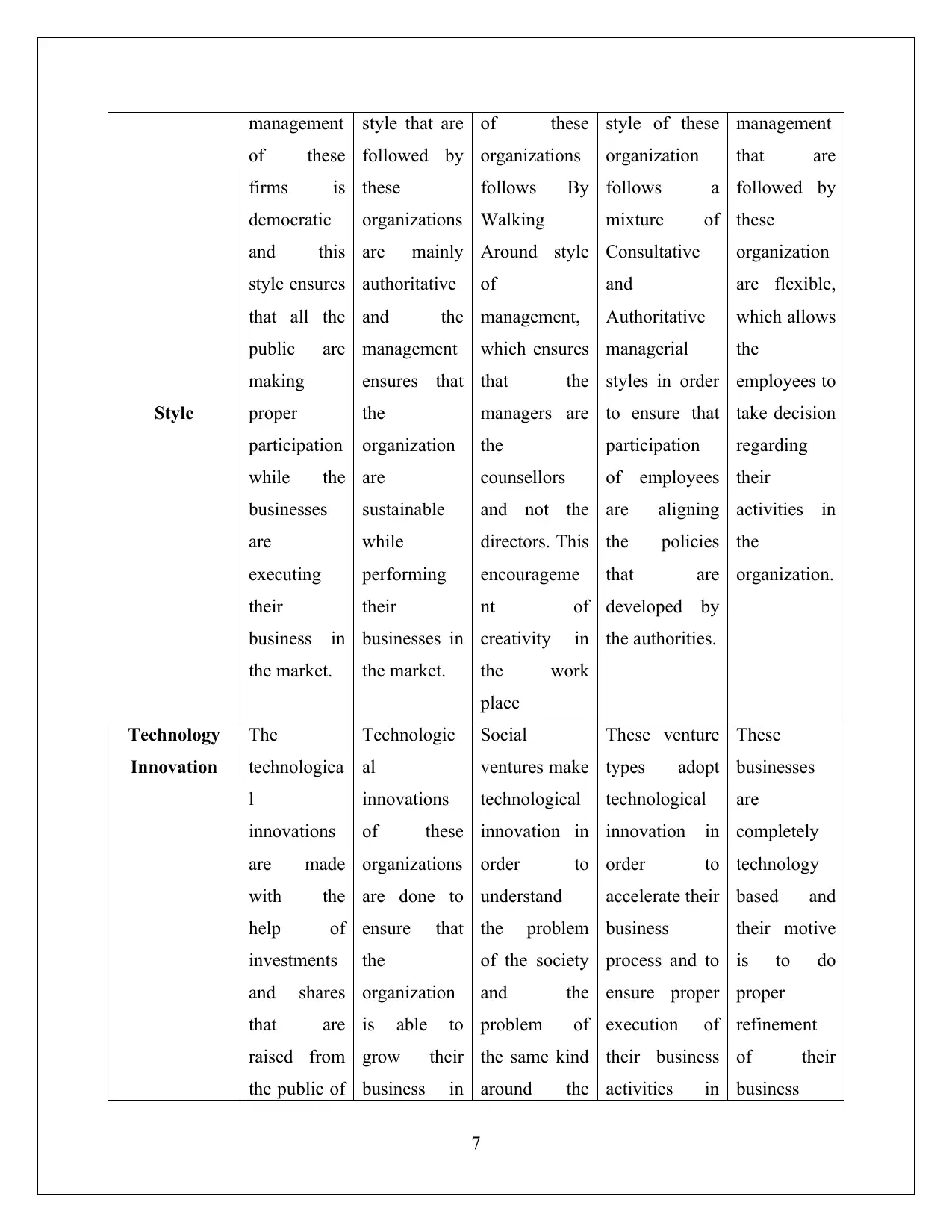
Style
management
of these
firms is
democratic
and this
style ensures
that all the
public are
making
proper
participation
while the
businesses
are
executing
their
business in
the market.
style that are
followed by
these
organizations
are mainly
authoritative
and the
management
ensures that
the
organization
are
sustainable
while
performing
their
businesses in
the market.
of these
organizations
follows By
Walking
Around style
of
management,
which ensures
that the
managers are
the
counsellors
and not the
directors. This
encourageme
nt of
creativity in
the work
place
style of these
organization
follows a
mixture of
Consultative
and
Authoritative
managerial
styles in order
to ensure that
participation
of employees
are aligning
the policies
that are
developed by
the authorities.
management
that are
followed by
these
organization
are flexible,
which allows
the
employees to
take decision
regarding
their
activities in
the
organization.
Technology
Innovation
The
technologica
l
innovations
are made
with the
help of
investments
and shares
that are
raised from
the public of
Technologic
al
innovations
of these
organizations
are done to
ensure that
the
organization
is able to
grow their
business in
Social
ventures make
technological
innovation in
order to
understand
the problem
of the society
and the
problem of
the same kind
around the
These venture
types adopt
technological
innovation in
order to
accelerate their
business
process and to
ensure proper
execution of
their business
activities in
These
businesses
are
completely
technology
based and
their motive
is to do
proper
refinement
of their
business
7
management
of these
firms is
democratic
and this
style ensures
that all the
public are
making
proper
participation
while the
businesses
are
executing
their
business in
the market.
style that are
followed by
these
organizations
are mainly
authoritative
and the
management
ensures that
the
organization
are
sustainable
while
performing
their
businesses in
the market.
of these
organizations
follows By
Walking
Around style
of
management,
which ensures
that the
managers are
the
counsellors
and not the
directors. This
encourageme
nt of
creativity in
the work
place
style of these
organization
follows a
mixture of
Consultative
and
Authoritative
managerial
styles in order
to ensure that
participation
of employees
are aligning
the policies
that are
developed by
the authorities.
management
that are
followed by
these
organization
are flexible,
which allows
the
employees to
take decision
regarding
their
activities in
the
organization.
Technology
Innovation
The
technologica
l
innovations
are made
with the
help of
investments
and shares
that are
raised from
the public of
Technologic
al
innovations
of these
organizations
are done to
ensure that
the
organization
is able to
grow their
business in
Social
ventures make
technological
innovation in
order to
understand
the problem
of the society
and the
problem of
the same kind
around the
These venture
types adopt
technological
innovation in
order to
accelerate their
business
process and to
ensure proper
execution of
their business
activities in
These
businesses
are
completely
technology
based and
their motive
is to do
proper
refinement
of their
business
7
Paraphrase This Document
Need a fresh take? Get an instant paraphrase of this document with our AI Paraphraser

a society. the market
and even to
achieve the
set goals and
targets.
globe. Social
ventures even
focus on the
improvement
of
technologies
around the
globe.
their chosen
market.
process.
Source of
Finance
Both the
public and
the private
funds fund
these
ventures.
These
organizations
are funded
by internal
funding and
even from
external
funding. The
funding are
even from
the side of
the
entrepreneur
s and from
their
partners(if
any)
The financial
Source of
such ventures
are both
public
investments
as well as
government
investments
Bank credit is
one of the
mostly
common
funding option
for these
businesses.
Apart from
this, the
organizations
are even
funded by the
government
and private
bodies.
Private and
crowd
funding are
the two main
ways in
which these
organization
s are funded.
Table 1: Differences between entrepreneurial ventures
(Source: Created by the learner)
Similarities among the venture types:
8
and even to
achieve the
set goals and
targets.
globe. Social
ventures even
focus on the
improvement
of
technologies
around the
globe.
their chosen
market.
process.
Source of
Finance
Both the
public and
the private
funds fund
these
ventures.
These
organizations
are funded
by internal
funding and
even from
external
funding. The
funding are
even from
the side of
the
entrepreneur
s and from
their
partners(if
any)
The financial
Source of
such ventures
are both
public
investments
as well as
government
investments
Bank credit is
one of the
mostly
common
funding option
for these
businesses.
Apart from
this, the
organizations
are even
funded by the
government
and private
bodies.
Private and
crowd
funding are
the two main
ways in
which these
organization
s are funded.
Table 1: Differences between entrepreneurial ventures
(Source: Created by the learner)
Similarities among the venture types:
8

All the venture types are with the motive to serve, some are with the motive to earn
money from their servings while others are with the motive to earn profit.
The ventures that are discussed above are with the mentality to face the risks while
performing their businesses in the market.
For all the discussed ventures, it is essential to have proper vision and mission in order to
serve the customers.
All the discussed entrepreneurships have the scope of development and innovation while
executing their business in their chosen location.
All of the discussed business types are having the organization structures and they follow
the line of authority.
3. Collecting and presenting statistical Data as an evidence on how micro and small
businesses impact on economy. This statistical data can be sourced from internet and
focused on UK small and medium size enterprises.
Micro and small businesses are becoming the fundamental units of the UK economy. The growth
of small and micro businesses in the UK economy are increasing at a fast pace and this creating
huge scope of employment in the economy.
Figure 1: Growth of Small and Big businesses in UK market
(Source: Charlie Elphicke MP, 2018)
9
money from their servings while others are with the motive to earn profit.
The ventures that are discussed above are with the mentality to face the risks while
performing their businesses in the market.
For all the discussed ventures, it is essential to have proper vision and mission in order to
serve the customers.
All the discussed entrepreneurships have the scope of development and innovation while
executing their business in their chosen location.
All of the discussed business types are having the organization structures and they follow
the line of authority.
3. Collecting and presenting statistical Data as an evidence on how micro and small
businesses impact on economy. This statistical data can be sourced from internet and
focused on UK small and medium size enterprises.
Micro and small businesses are becoming the fundamental units of the UK economy. The growth
of small and micro businesses in the UK economy are increasing at a fast pace and this creating
huge scope of employment in the economy.
Figure 1: Growth of Small and Big businesses in UK market
(Source: Charlie Elphicke MP, 2018)
9
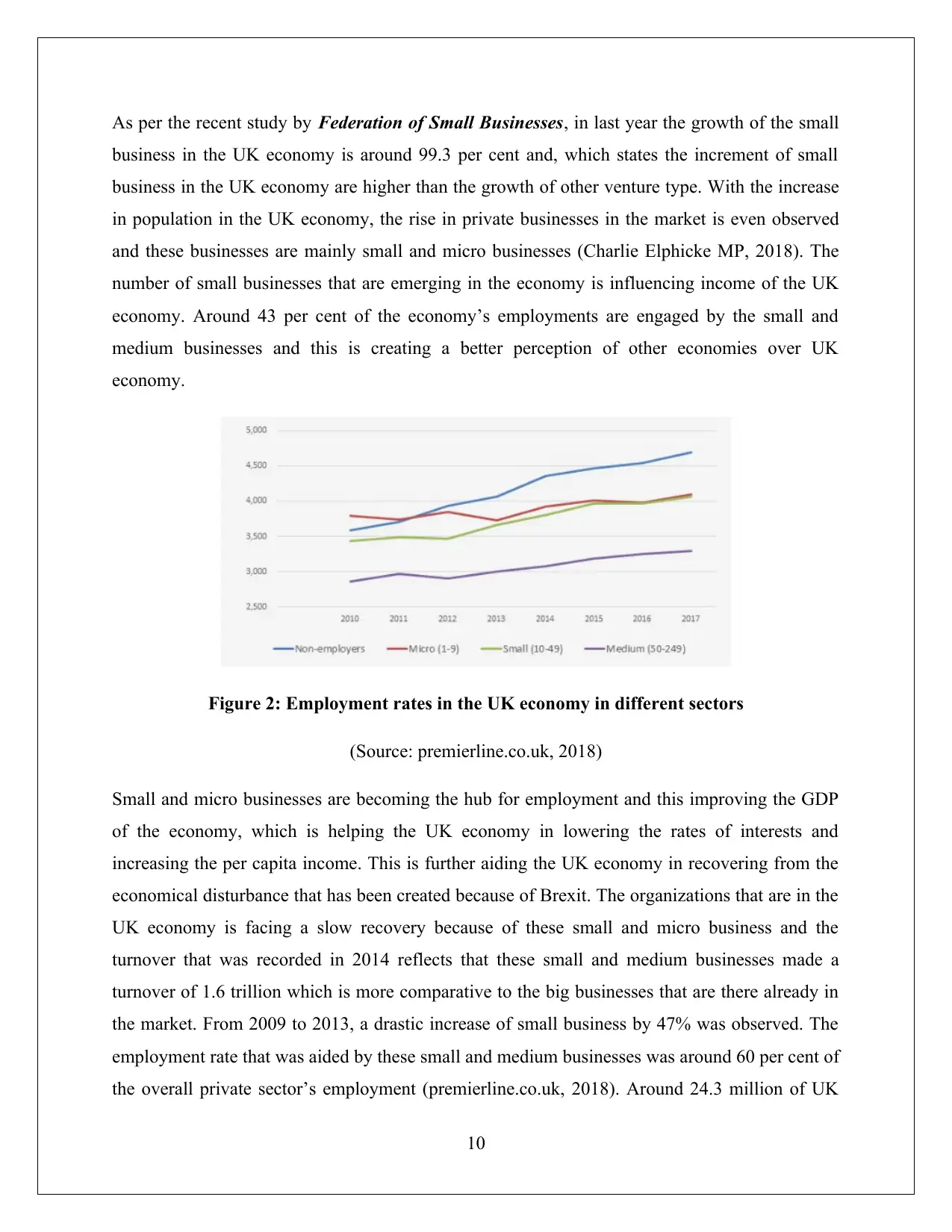
As per the recent study by Federation of Small Businesses, in last year the growth of the small
business in the UK economy is around 99.3 per cent and, which states the increment of small
business in the UK economy are higher than the growth of other venture type. With the increase
in population in the UK economy, the rise in private businesses in the market is even observed
and these businesses are mainly small and micro businesses (Charlie Elphicke MP, 2018). The
number of small businesses that are emerging in the economy is influencing income of the UK
economy. Around 43 per cent of the economy’s employments are engaged by the small and
medium businesses and this is creating a better perception of other economies over UK
economy.
Figure 2: Employment rates in the UK economy in different sectors
(Source: premierline.co.uk, 2018)
Small and micro businesses are becoming the hub for employment and this improving the GDP
of the economy, which is helping the UK economy in lowering the rates of interests and
increasing the per capita income. This is further aiding the UK economy in recovering from the
economical disturbance that has been created because of Brexit. The organizations that are in the
UK economy is facing a slow recovery because of these small and micro business and the
turnover that was recorded in 2014 reflects that these small and medium businesses made a
turnover of 1.6 trillion which is more comparative to the big businesses that are there already in
the market. From 2009 to 2013, a drastic increase of small business by 47% was observed. The
employment rate that was aided by these small and medium businesses was around 60 per cent of
the overall private sector’s employment (premierline.co.uk, 2018). Around 24.3 million of UK
10
business in the UK economy is around 99.3 per cent and, which states the increment of small
business in the UK economy are higher than the growth of other venture type. With the increase
in population in the UK economy, the rise in private businesses in the market is even observed
and these businesses are mainly small and micro businesses (Charlie Elphicke MP, 2018). The
number of small businesses that are emerging in the economy is influencing income of the UK
economy. Around 43 per cent of the economy’s employments are engaged by the small and
medium businesses and this is creating a better perception of other economies over UK
economy.
Figure 2: Employment rates in the UK economy in different sectors
(Source: premierline.co.uk, 2018)
Small and micro businesses are becoming the hub for employment and this improving the GDP
of the economy, which is helping the UK economy in lowering the rates of interests and
increasing the per capita income. This is further aiding the UK economy in recovering from the
economical disturbance that has been created because of Brexit. The organizations that are in the
UK economy is facing a slow recovery because of these small and micro business and the
turnover that was recorded in 2014 reflects that these small and medium businesses made a
turnover of 1.6 trillion which is more comparative to the big businesses that are there already in
the market. From 2009 to 2013, a drastic increase of small business by 47% was observed. The
employment rate that was aided by these small and medium businesses was around 60 per cent of
the overall private sector’s employment (premierline.co.uk, 2018). Around 24.3 million of UK
10
Secure Best Marks with AI Grader
Need help grading? Try our AI Grader for instant feedback on your assignments.
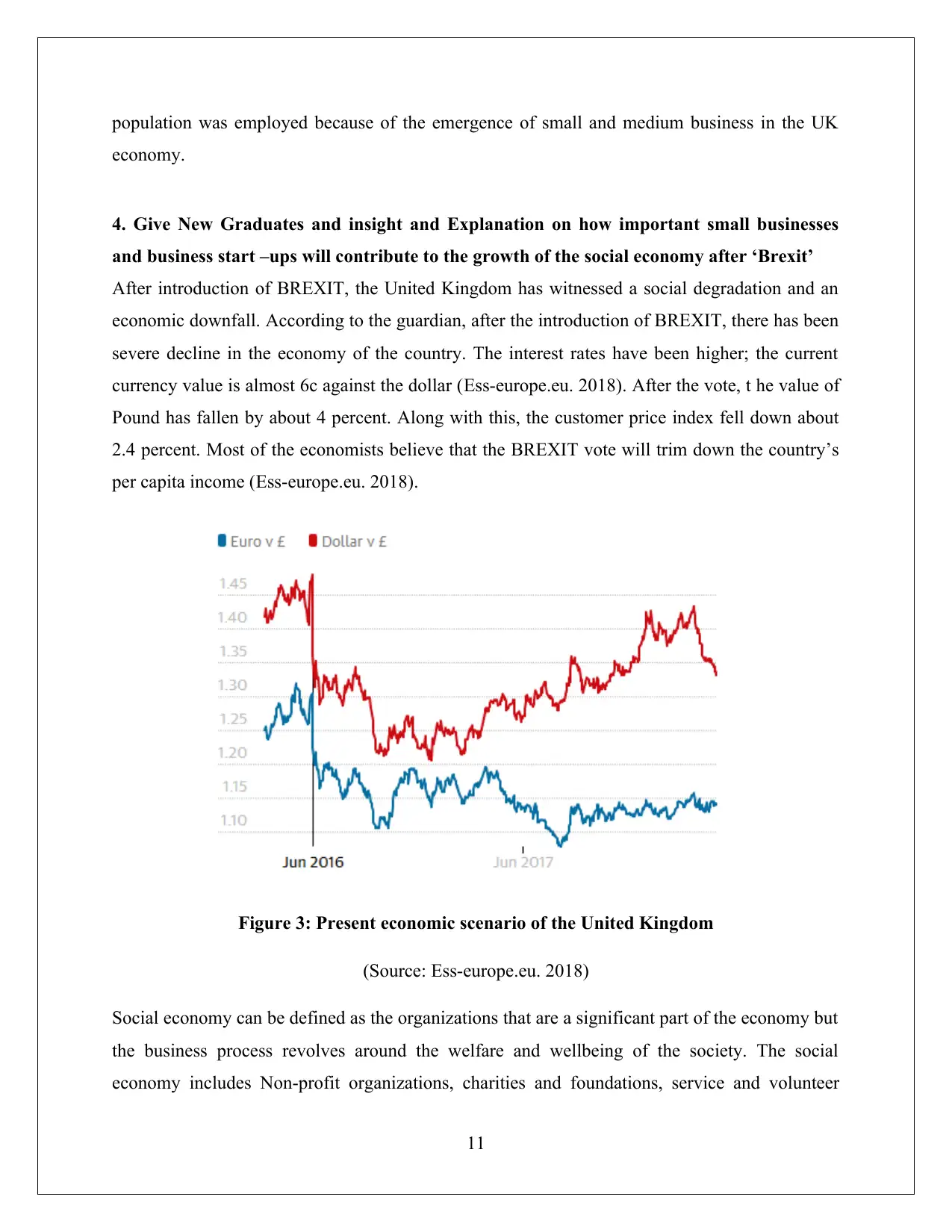
population was employed because of the emergence of small and medium business in the UK
economy.
4. Give New Graduates and insight and Explanation on how important small businesses
and business start –ups will contribute to the growth of the social economy after ‘Brexit’
After introduction of BREXIT, the United Kingdom has witnessed a social degradation and an
economic downfall. According to the guardian, after the introduction of BREXIT, there has been
severe decline in the economy of the country. The interest rates have been higher; the current
currency value is almost 6c against the dollar (Ess-europe.eu. 2018). After the vote, t he value of
Pound has fallen by about 4 percent. Along with this, the customer price index fell down about
2.4 percent. Most of the economists believe that the BREXIT vote will trim down the country’s
per capita income (Ess-europe.eu. 2018).
Figure 3: Present economic scenario of the United Kingdom
(Source: Ess-europe.eu. 2018)
Social economy can be defined as the organizations that are a significant part of the economy but
the business process revolves around the welfare and wellbeing of the society. The social
economy includes Non-profit organizations, charities and foundations, service and volunteer
11
economy.
4. Give New Graduates and insight and Explanation on how important small businesses
and business start –ups will contribute to the growth of the social economy after ‘Brexit’
After introduction of BREXIT, the United Kingdom has witnessed a social degradation and an
economic downfall. According to the guardian, after the introduction of BREXIT, there has been
severe decline in the economy of the country. The interest rates have been higher; the current
currency value is almost 6c against the dollar (Ess-europe.eu. 2018). After the vote, t he value of
Pound has fallen by about 4 percent. Along with this, the customer price index fell down about
2.4 percent. Most of the economists believe that the BREXIT vote will trim down the country’s
per capita income (Ess-europe.eu. 2018).
Figure 3: Present economic scenario of the United Kingdom
(Source: Ess-europe.eu. 2018)
Social economy can be defined as the organizations that are a significant part of the economy but
the business process revolves around the welfare and wellbeing of the society. The social
economy includes Non-profit organizations, charities and foundations, service and volunteer
11
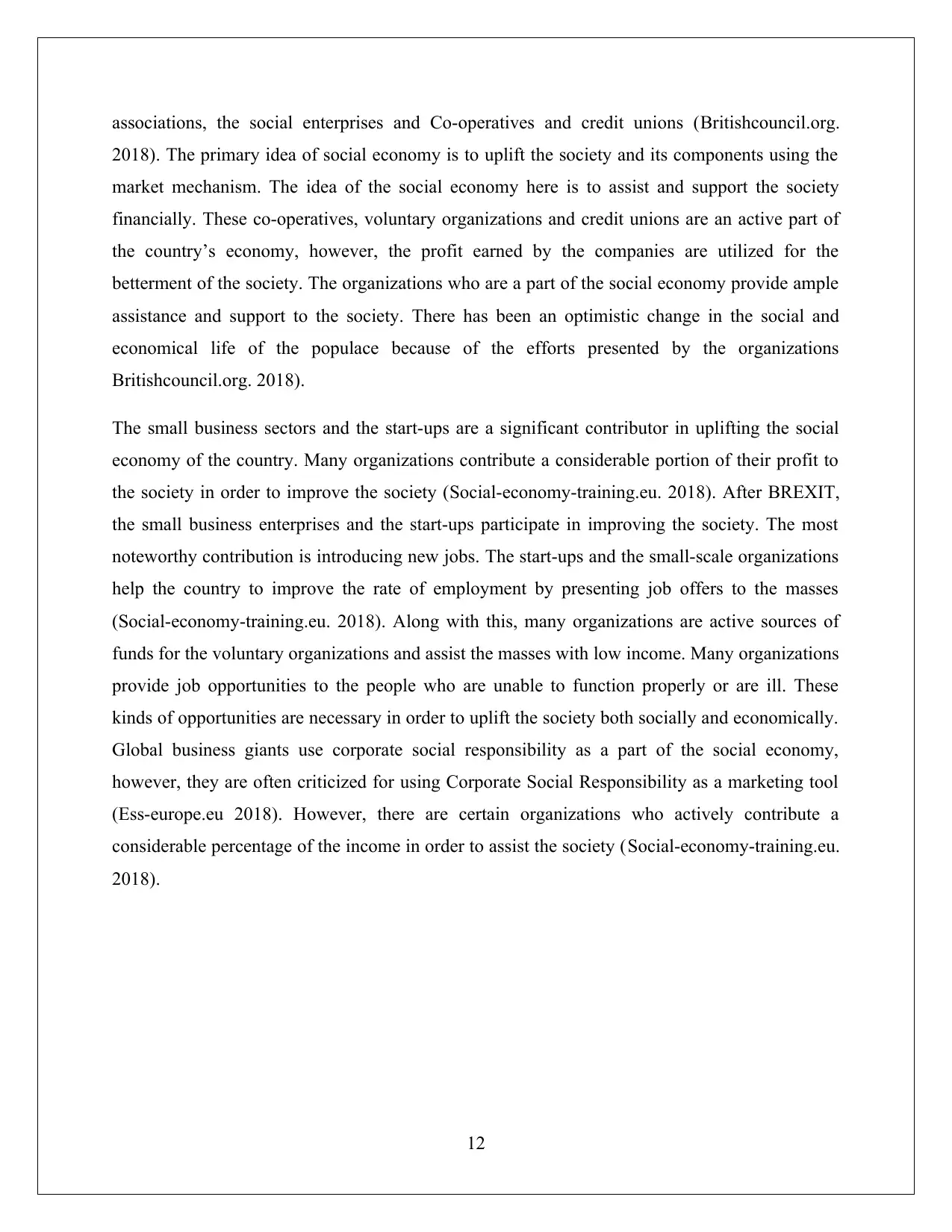
associations, the social enterprises and Co-operatives and credit unions (Britishcouncil.org.
2018). The primary idea of social economy is to uplift the society and its components using the
market mechanism. The idea of the social economy here is to assist and support the society
financially. These co-operatives, voluntary organizations and credit unions are an active part of
the country’s economy, however, the profit earned by the companies are utilized for the
betterment of the society. The organizations who are a part of the social economy provide ample
assistance and support to the society. There has been an optimistic change in the social and
economical life of the populace because of the efforts presented by the organizations
Britishcouncil.org. 2018).
The small business sectors and the start-ups are a significant contributor in uplifting the social
economy of the country. Many organizations contribute a considerable portion of their profit to
the society in order to improve the society (Social-economy-training.eu. 2018). After BREXIT,
the small business enterprises and the start-ups participate in improving the society. The most
noteworthy contribution is introducing new jobs. The start-ups and the small-scale organizations
help the country to improve the rate of employment by presenting job offers to the masses
(Social-economy-training.eu. 2018). Along with this, many organizations are active sources of
funds for the voluntary organizations and assist the masses with low income. Many organizations
provide job opportunities to the people who are unable to function properly or are ill. These
kinds of opportunities are necessary in order to uplift the society both socially and economically.
Global business giants use corporate social responsibility as a part of the social economy,
however, they are often criticized for using Corporate Social Responsibility as a marketing tool
(Ess-europe.eu 2018). However, there are certain organizations who actively contribute a
considerable percentage of the income in order to assist the society (Social-economy-training.eu.
2018).
12
2018). The primary idea of social economy is to uplift the society and its components using the
market mechanism. The idea of the social economy here is to assist and support the society
financially. These co-operatives, voluntary organizations and credit unions are an active part of
the country’s economy, however, the profit earned by the companies are utilized for the
betterment of the society. The organizations who are a part of the social economy provide ample
assistance and support to the society. There has been an optimistic change in the social and
economical life of the populace because of the efforts presented by the organizations
Britishcouncil.org. 2018).
The small business sectors and the start-ups are a significant contributor in uplifting the social
economy of the country. Many organizations contribute a considerable portion of their profit to
the society in order to improve the society (Social-economy-training.eu. 2018). After BREXIT,
the small business enterprises and the start-ups participate in improving the society. The most
noteworthy contribution is introducing new jobs. The start-ups and the small-scale organizations
help the country to improve the rate of employment by presenting job offers to the masses
(Social-economy-training.eu. 2018). Along with this, many organizations are active sources of
funds for the voluntary organizations and assist the masses with low income. Many organizations
provide job opportunities to the people who are unable to function properly or are ill. These
kinds of opportunities are necessary in order to uplift the society both socially and economically.
Global business giants use corporate social responsibility as a part of the social economy,
however, they are often criticized for using Corporate Social Responsibility as a marketing tool
(Ess-europe.eu 2018). However, there are certain organizations who actively contribute a
considerable percentage of the income in order to assist the society (Social-economy-training.eu.
2018).
12
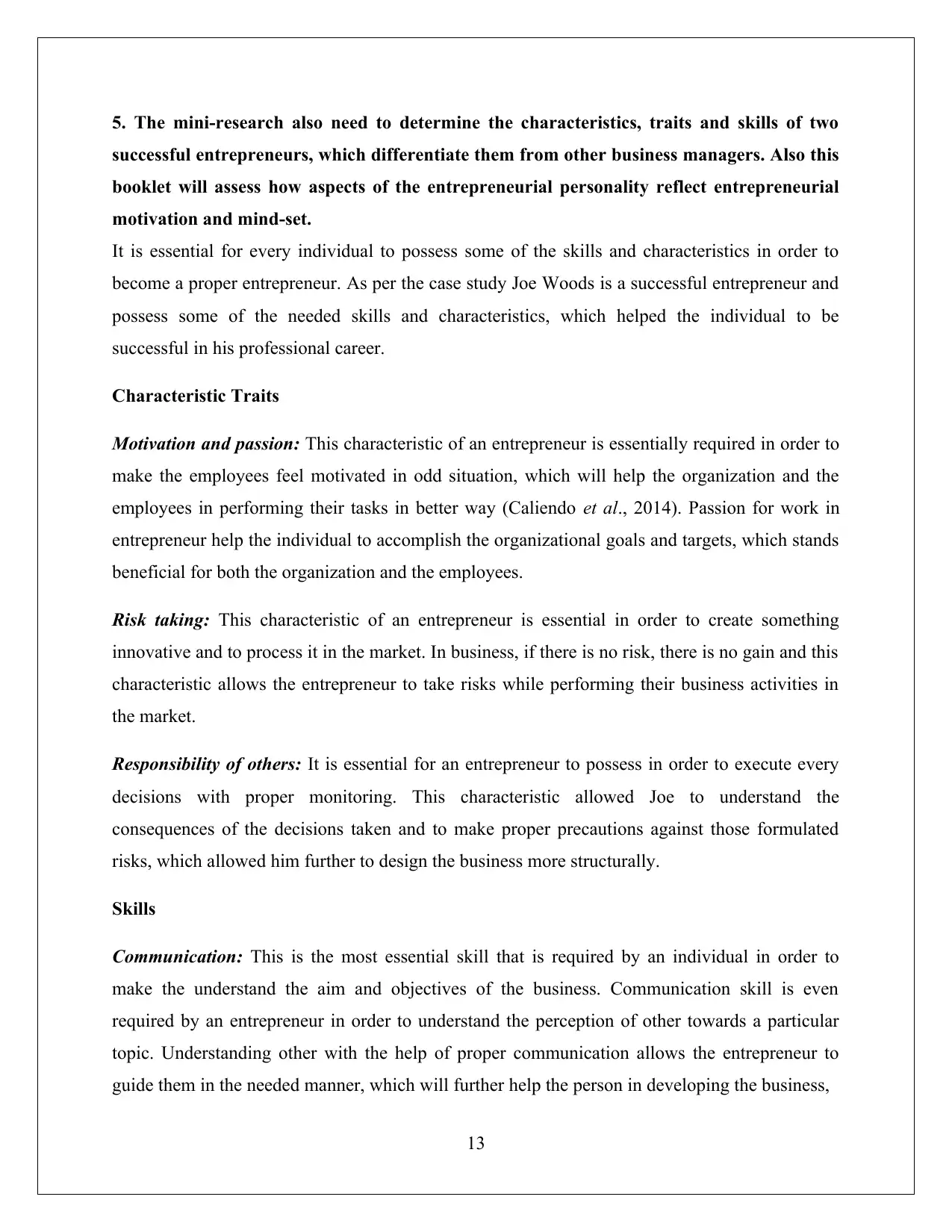
5. The mini-research also need to determine the characteristics, traits and skills of two
successful entrepreneurs, which differentiate them from other business managers. Also this
booklet will assess how aspects of the entrepreneurial personality reflect entrepreneurial
motivation and mind-set.
It is essential for every individual to possess some of the skills and characteristics in order to
become a proper entrepreneur. As per the case study Joe Woods is a successful entrepreneur and
possess some of the needed skills and characteristics, which helped the individual to be
successful in his professional career.
Characteristic Traits
Motivation and passion: This characteristic of an entrepreneur is essentially required in order to
make the employees feel motivated in odd situation, which will help the organization and the
employees in performing their tasks in better way (Caliendo et al., 2014). Passion for work in
entrepreneur help the individual to accomplish the organizational goals and targets, which stands
beneficial for both the organization and the employees.
Risk taking: This characteristic of an entrepreneur is essential in order to create something
innovative and to process it in the market. In business, if there is no risk, there is no gain and this
characteristic allows the entrepreneur to take risks while performing their business activities in
the market.
Responsibility of others: It is essential for an entrepreneur to possess in order to execute every
decisions with proper monitoring. This characteristic allowed Joe to understand the
consequences of the decisions taken and to make proper precautions against those formulated
risks, which allowed him further to design the business more structurally.
Skills
Communication: This is the most essential skill that is required by an individual in order to
make the understand the aim and objectives of the business. Communication skill is even
required by an entrepreneur in order to understand the perception of other towards a particular
topic. Understanding other with the help of proper communication allows the entrepreneur to
guide them in the needed manner, which will further help the person in developing the business,
13
successful entrepreneurs, which differentiate them from other business managers. Also this
booklet will assess how aspects of the entrepreneurial personality reflect entrepreneurial
motivation and mind-set.
It is essential for every individual to possess some of the skills and characteristics in order to
become a proper entrepreneur. As per the case study Joe Woods is a successful entrepreneur and
possess some of the needed skills and characteristics, which helped the individual to be
successful in his professional career.
Characteristic Traits
Motivation and passion: This characteristic of an entrepreneur is essentially required in order to
make the employees feel motivated in odd situation, which will help the organization and the
employees in performing their tasks in better way (Caliendo et al., 2014). Passion for work in
entrepreneur help the individual to accomplish the organizational goals and targets, which stands
beneficial for both the organization and the employees.
Risk taking: This characteristic of an entrepreneur is essential in order to create something
innovative and to process it in the market. In business, if there is no risk, there is no gain and this
characteristic allows the entrepreneur to take risks while performing their business activities in
the market.
Responsibility of others: It is essential for an entrepreneur to possess in order to execute every
decisions with proper monitoring. This characteristic allowed Joe to understand the
consequences of the decisions taken and to make proper precautions against those formulated
risks, which allowed him further to design the business more structurally.
Skills
Communication: This is the most essential skill that is required by an individual in order to
make the understand the aim and objectives of the business. Communication skill is even
required by an entrepreneur in order to understand the perception of other towards a particular
topic. Understanding other with the help of proper communication allows the entrepreneur to
guide them in the needed manner, which will further help the person in developing the business,
13
Paraphrase This Document
Need a fresh take? Get an instant paraphrase of this document with our AI Paraphraser
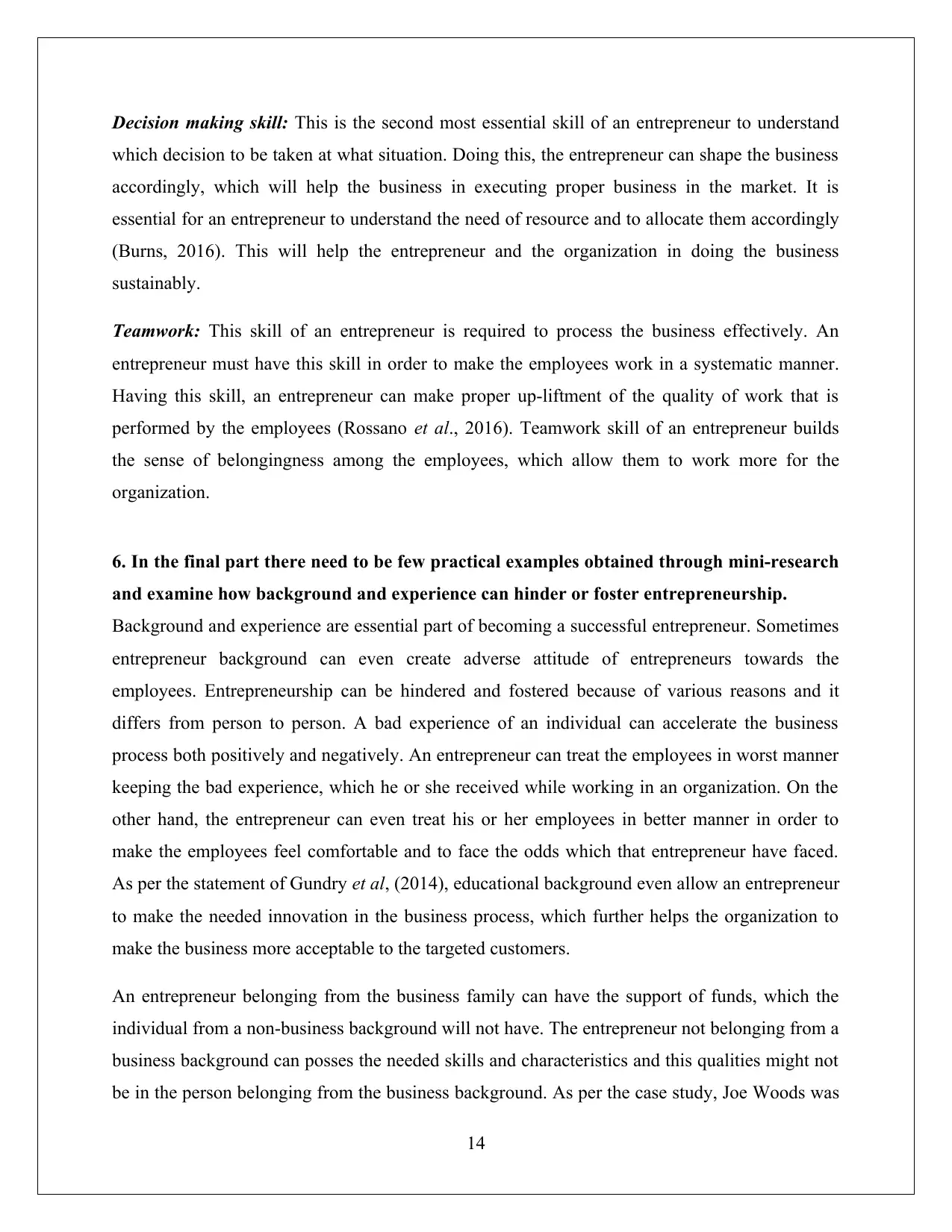
Decision making skill: This is the second most essential skill of an entrepreneur to understand
which decision to be taken at what situation. Doing this, the entrepreneur can shape the business
accordingly, which will help the business in executing proper business in the market. It is
essential for an entrepreneur to understand the need of resource and to allocate them accordingly
(Burns, 2016). This will help the entrepreneur and the organization in doing the business
sustainably.
Teamwork: This skill of an entrepreneur is required to process the business effectively. An
entrepreneur must have this skill in order to make the employees work in a systematic manner.
Having this skill, an entrepreneur can make proper up-liftment of the quality of work that is
performed by the employees (Rossano et al., 2016). Teamwork skill of an entrepreneur builds
the sense of belongingness among the employees, which allow them to work more for the
organization.
6. In the final part there need to be few practical examples obtained through mini-research
and examine how background and experience can hinder or foster entrepreneurship.
Background and experience are essential part of becoming a successful entrepreneur. Sometimes
entrepreneur background can even create adverse attitude of entrepreneurs towards the
employees. Entrepreneurship can be hindered and fostered because of various reasons and it
differs from person to person. A bad experience of an individual can accelerate the business
process both positively and negatively. An entrepreneur can treat the employees in worst manner
keeping the bad experience, which he or she received while working in an organization. On the
other hand, the entrepreneur can even treat his or her employees in better manner in order to
make the employees feel comfortable and to face the odds which that entrepreneur have faced.
As per the statement of Gundry et al, (2014), educational background even allow an entrepreneur
to make the needed innovation in the business process, which further helps the organization to
make the business more acceptable to the targeted customers.
An entrepreneur belonging from the business family can have the support of funds, which the
individual from a non-business background will not have. The entrepreneur not belonging from a
business background can posses the needed skills and characteristics and this qualities might not
be in the person belonging from the business background. As per the case study, Joe Woods was
14
which decision to be taken at what situation. Doing this, the entrepreneur can shape the business
accordingly, which will help the business in executing proper business in the market. It is
essential for an entrepreneur to understand the need of resource and to allocate them accordingly
(Burns, 2016). This will help the entrepreneur and the organization in doing the business
sustainably.
Teamwork: This skill of an entrepreneur is required to process the business effectively. An
entrepreneur must have this skill in order to make the employees work in a systematic manner.
Having this skill, an entrepreneur can make proper up-liftment of the quality of work that is
performed by the employees (Rossano et al., 2016). Teamwork skill of an entrepreneur builds
the sense of belongingness among the employees, which allow them to work more for the
organization.
6. In the final part there need to be few practical examples obtained through mini-research
and examine how background and experience can hinder or foster entrepreneurship.
Background and experience are essential part of becoming a successful entrepreneur. Sometimes
entrepreneur background can even create adverse attitude of entrepreneurs towards the
employees. Entrepreneurship can be hindered and fostered because of various reasons and it
differs from person to person. A bad experience of an individual can accelerate the business
process both positively and negatively. An entrepreneur can treat the employees in worst manner
keeping the bad experience, which he or she received while working in an organization. On the
other hand, the entrepreneur can even treat his or her employees in better manner in order to
make the employees feel comfortable and to face the odds which that entrepreneur have faced.
As per the statement of Gundry et al, (2014), educational background even allow an entrepreneur
to make the needed innovation in the business process, which further helps the organization to
make the business more acceptable to the targeted customers.
An entrepreneur belonging from the business family can have the support of funds, which the
individual from a non-business background will not have. The entrepreneur not belonging from a
business background can posses the needed skills and characteristics and this qualities might not
be in the person belonging from the business background. As per the case study, Joe Woods was
14
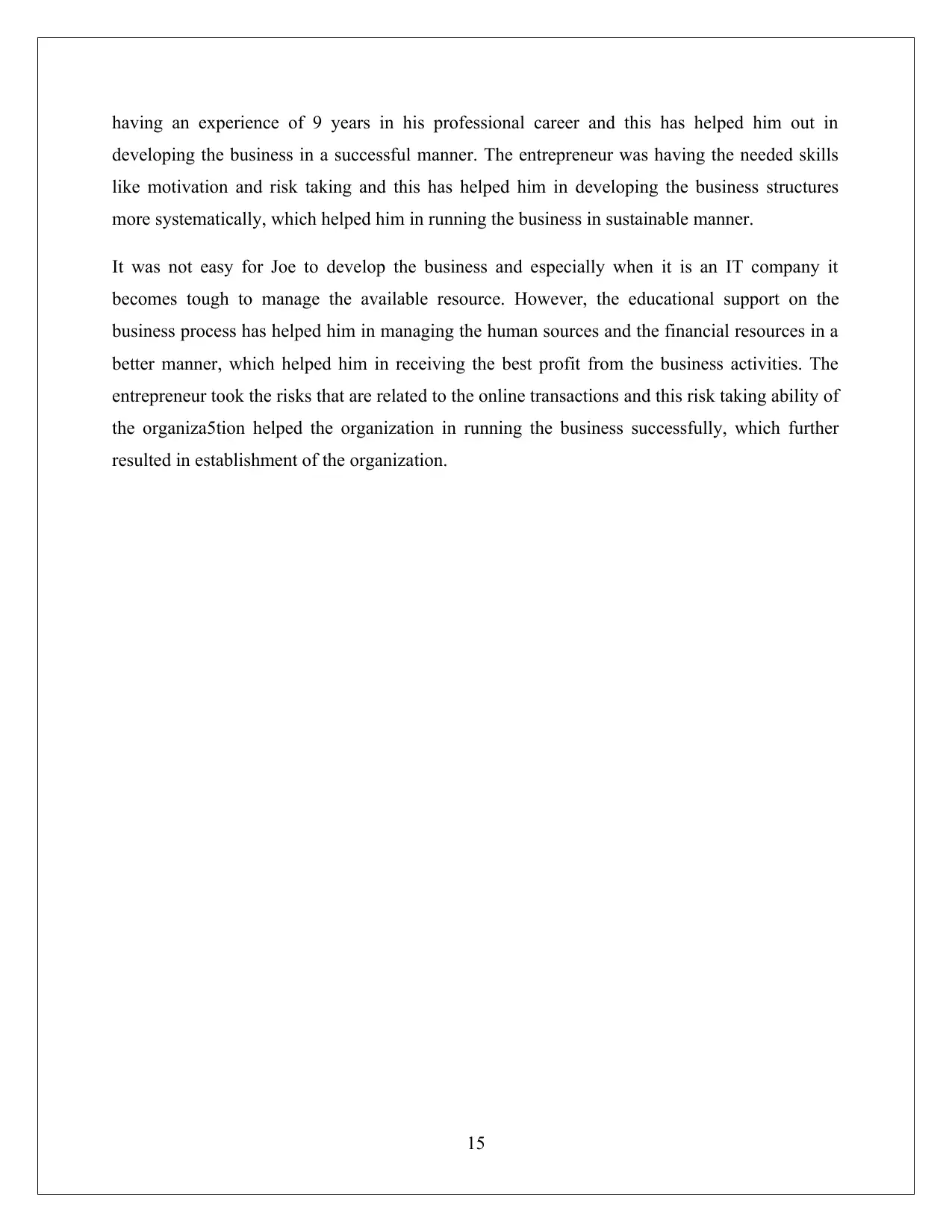
having an experience of 9 years in his professional career and this has helped him out in
developing the business in a successful manner. The entrepreneur was having the needed skills
like motivation and risk taking and this has helped him in developing the business structures
more systematically, which helped him in running the business in sustainable manner.
It was not easy for Joe to develop the business and especially when it is an IT company it
becomes tough to manage the available resource. However, the educational support on the
business process has helped him in managing the human sources and the financial resources in a
better manner, which helped him in receiving the best profit from the business activities. The
entrepreneur took the risks that are related to the online transactions and this risk taking ability of
the organiza5tion helped the organization in running the business successfully, which further
resulted in establishment of the organization.
15
developing the business in a successful manner. The entrepreneur was having the needed skills
like motivation and risk taking and this has helped him in developing the business structures
more systematically, which helped him in running the business in sustainable manner.
It was not easy for Joe to develop the business and especially when it is an IT company it
becomes tough to manage the available resource. However, the educational support on the
business process has helped him in managing the human sources and the financial resources in a
better manner, which helped him in receiving the best profit from the business activities. The
entrepreneur took the risks that are related to the online transactions and this risk taking ability of
the organiza5tion helped the organization in running the business successfully, which further
resulted in establishment of the organization.
15

Conclusion
After accomplishing this assignment, it can be concluded that small and medium sized
businesses are becoming the pillar units of the UK economy. The organizations that are there in
the economy of UK, especially the small businesses are increasing at a rapid rate and this is
creating a boost to the economy. To become a successful entrepreneur, it is essential to have
some of the skills like, motivation and responsibility of the decisions taken and this skill of an
individual helps in shaping the business in a proper manner. It is not essential for an entrepreneur
to belong from a business background to become a better entrepreneur. Even an individual who
is not belonging from the business family can be a better entrepreneur.
16
After accomplishing this assignment, it can be concluded that small and medium sized
businesses are becoming the pillar units of the UK economy. The organizations that are there in
the economy of UK, especially the small businesses are increasing at a rapid rate and this is
creating a boost to the economy. To become a successful entrepreneur, it is essential to have
some of the skills like, motivation and responsibility of the decisions taken and this skill of an
individual helps in shaping the business in a proper manner. It is not essential for an entrepreneur
to belong from a business background to become a better entrepreneur. Even an individual who
is not belonging from the business family can be a better entrepreneur.
16
Secure Best Marks with AI Grader
Need help grading? Try our AI Grader for instant feedback on your assignments.
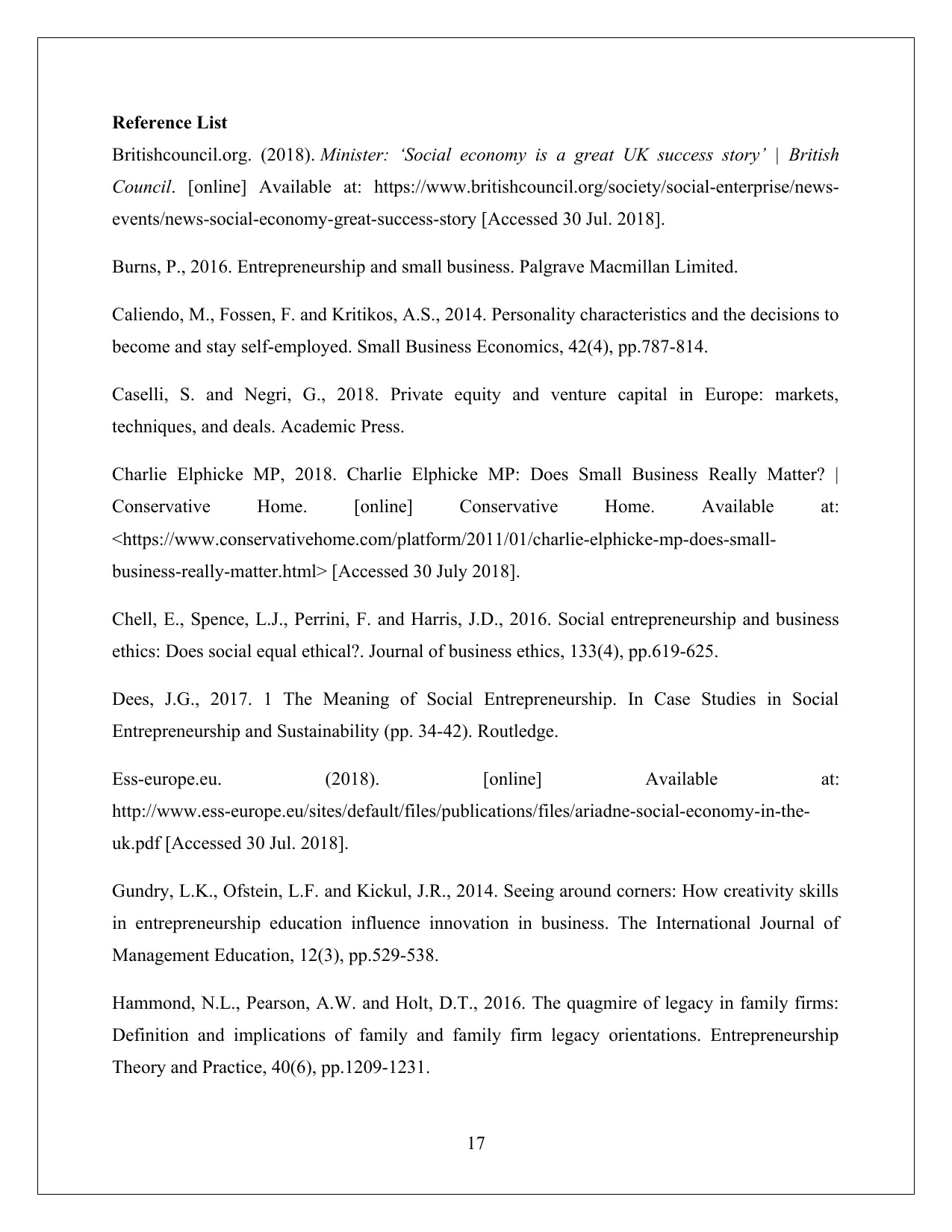
Reference List
Britishcouncil.org. (2018). Minister: ‘Social economy is a great UK success story’ | British
Council. [online] Available at: https://www.britishcouncil.org/society/social-enterprise/news-
events/news-social-economy-great-success-story [Accessed 30 Jul. 2018].
Burns, P., 2016. Entrepreneurship and small business. Palgrave Macmillan Limited.
Caliendo, M., Fossen, F. and Kritikos, A.S., 2014. Personality characteristics and the decisions to
become and stay self-employed. Small Business Economics, 42(4), pp.787-814.
Caselli, S. and Negri, G., 2018. Private equity and venture capital in Europe: markets,
techniques, and deals. Academic Press.
Charlie Elphicke MP, 2018. Charlie Elphicke MP: Does Small Business Really Matter? |
Conservative Home. [online] Conservative Home. Available at:
<https://www.conservativehome.com/platform/2011/01/charlie-elphicke-mp-does-small-
business-really-matter.html> [Accessed 30 July 2018].
Chell, E., Spence, L.J., Perrini, F. and Harris, J.D., 2016. Social entrepreneurship and business
ethics: Does social equal ethical?. Journal of business ethics, 133(4), pp.619-625.
Dees, J.G., 2017. 1 The Meaning of Social Entrepreneurship. In Case Studies in Social
Entrepreneurship and Sustainability (pp. 34-42). Routledge.
Ess-europe.eu. (2018). [online] Available at:
http://www.ess-europe.eu/sites/default/files/publications/files/ariadne-social-economy-in-the-
uk.pdf [Accessed 30 Jul. 2018].
Gundry, L.K., Ofstein, L.F. and Kickul, J.R., 2014. Seeing around corners: How creativity skills
in entrepreneurship education influence innovation in business. The International Journal of
Management Education, 12(3), pp.529-538.
Hammond, N.L., Pearson, A.W. and Holt, D.T., 2016. The quagmire of legacy in family firms:
Definition and implications of family and family firm legacy orientations. Entrepreneurship
Theory and Practice, 40(6), pp.1209-1231.
17
Britishcouncil.org. (2018). Minister: ‘Social economy is a great UK success story’ | British
Council. [online] Available at: https://www.britishcouncil.org/society/social-enterprise/news-
events/news-social-economy-great-success-story [Accessed 30 Jul. 2018].
Burns, P., 2016. Entrepreneurship and small business. Palgrave Macmillan Limited.
Caliendo, M., Fossen, F. and Kritikos, A.S., 2014. Personality characteristics and the decisions to
become and stay self-employed. Small Business Economics, 42(4), pp.787-814.
Caselli, S. and Negri, G., 2018. Private equity and venture capital in Europe: markets,
techniques, and deals. Academic Press.
Charlie Elphicke MP, 2018. Charlie Elphicke MP: Does Small Business Really Matter? |
Conservative Home. [online] Conservative Home. Available at:
<https://www.conservativehome.com/platform/2011/01/charlie-elphicke-mp-does-small-
business-really-matter.html> [Accessed 30 July 2018].
Chell, E., Spence, L.J., Perrini, F. and Harris, J.D., 2016. Social entrepreneurship and business
ethics: Does social equal ethical?. Journal of business ethics, 133(4), pp.619-625.
Dees, J.G., 2017. 1 The Meaning of Social Entrepreneurship. In Case Studies in Social
Entrepreneurship and Sustainability (pp. 34-42). Routledge.
Ess-europe.eu. (2018). [online] Available at:
http://www.ess-europe.eu/sites/default/files/publications/files/ariadne-social-economy-in-the-
uk.pdf [Accessed 30 Jul. 2018].
Gundry, L.K., Ofstein, L.F. and Kickul, J.R., 2014. Seeing around corners: How creativity skills
in entrepreneurship education influence innovation in business. The International Journal of
Management Education, 12(3), pp.529-538.
Hammond, N.L., Pearson, A.W. and Holt, D.T., 2016. The quagmire of legacy in family firms:
Definition and implications of family and family firm legacy orientations. Entrepreneurship
Theory and Practice, 40(6), pp.1209-1231.
17
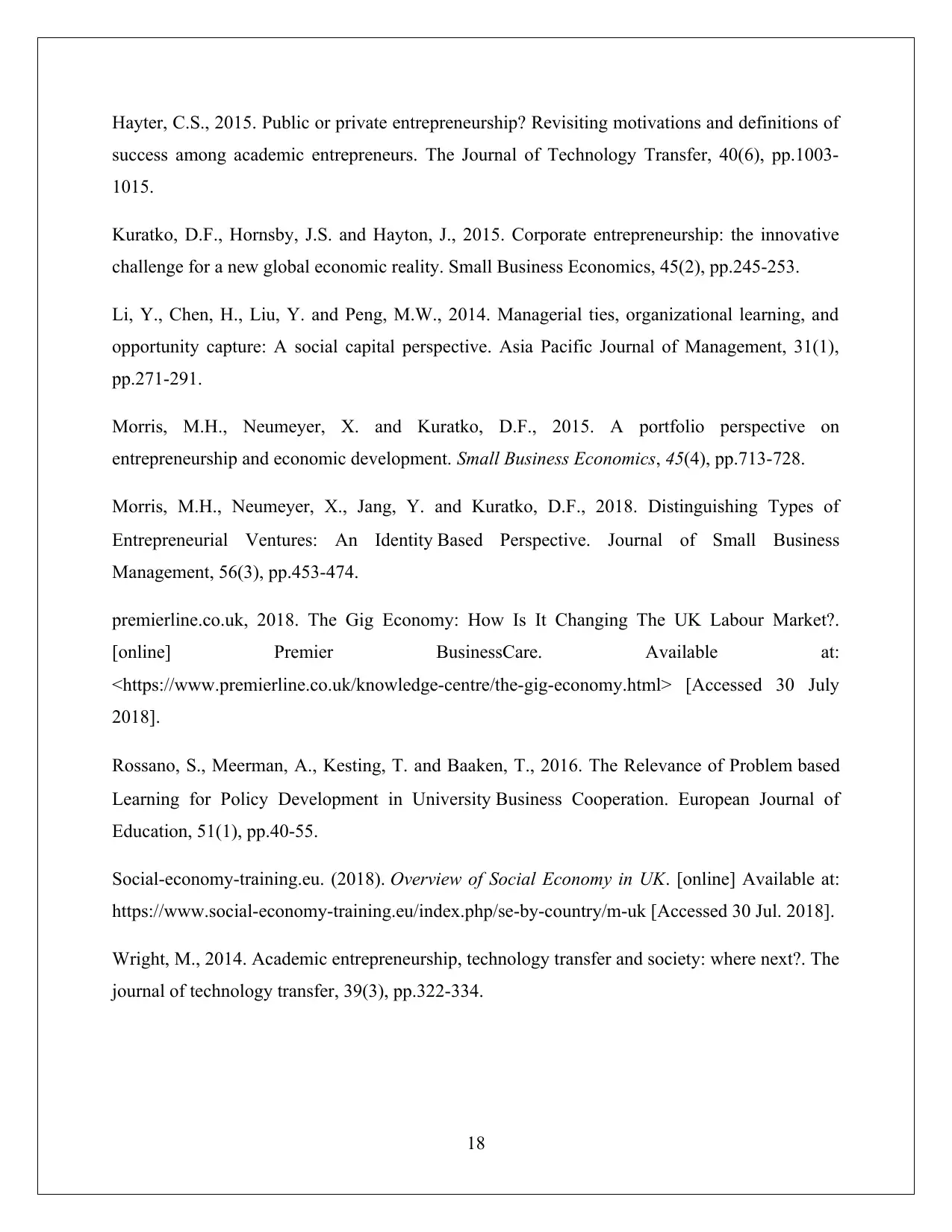
Hayter, C.S., 2015. Public or private entrepreneurship? Revisiting motivations and definitions of
success among academic entrepreneurs. The Journal of Technology Transfer, 40(6), pp.1003-
1015.
Kuratko, D.F., Hornsby, J.S. and Hayton, J., 2015. Corporate entrepreneurship: the innovative
challenge for a new global economic reality. Small Business Economics, 45(2), pp.245-253.
Li, Y., Chen, H., Liu, Y. and Peng, M.W., 2014. Managerial ties, organizational learning, and
opportunity capture: A social capital perspective. Asia Pacific Journal of Management, 31(1),
pp.271-291.
Morris, M.H., Neumeyer, X. and Kuratko, D.F., 2015. A portfolio perspective on
entrepreneurship and economic development. Small Business Economics, 45(4), pp.713-728.
Morris, M.H., Neumeyer, X., Jang, Y. and Kuratko, D.F., 2018. Distinguishing Types of
Entrepreneurial Ventures: An Identity‐Based Perspective. Journal of Small Business
Management, 56(3), pp.453-474.
premierline.co.uk, 2018. The Gig Economy: How Is It Changing The UK Labour Market?.
[online] Premier BusinessCare. Available at:
<https://www.premierline.co.uk/knowledge-centre/the-gig-economy.html> [Accessed 30 July
2018].
Rossano, S., Meerman, A., Kesting, T. and Baaken, T., 2016. The Relevance of Problem‐based
Learning for Policy Development in University‐Business Cooperation. European Journal of
Education, 51(1), pp.40-55.
Social-economy-training.eu. (2018). Overview of Social Economy in UK. [online] Available at:
https://www.social-economy-training.eu/index.php/se-by-country/m-uk [Accessed 30 Jul. 2018].
Wright, M., 2014. Academic entrepreneurship, technology transfer and society: where next?. The
journal of technology transfer, 39(3), pp.322-334.
18
success among academic entrepreneurs. The Journal of Technology Transfer, 40(6), pp.1003-
1015.
Kuratko, D.F., Hornsby, J.S. and Hayton, J., 2015. Corporate entrepreneurship: the innovative
challenge for a new global economic reality. Small Business Economics, 45(2), pp.245-253.
Li, Y., Chen, H., Liu, Y. and Peng, M.W., 2014. Managerial ties, organizational learning, and
opportunity capture: A social capital perspective. Asia Pacific Journal of Management, 31(1),
pp.271-291.
Morris, M.H., Neumeyer, X. and Kuratko, D.F., 2015. A portfolio perspective on
entrepreneurship and economic development. Small Business Economics, 45(4), pp.713-728.
Morris, M.H., Neumeyer, X., Jang, Y. and Kuratko, D.F., 2018. Distinguishing Types of
Entrepreneurial Ventures: An Identity‐Based Perspective. Journal of Small Business
Management, 56(3), pp.453-474.
premierline.co.uk, 2018. The Gig Economy: How Is It Changing The UK Labour Market?.
[online] Premier BusinessCare. Available at:
<https://www.premierline.co.uk/knowledge-centre/the-gig-economy.html> [Accessed 30 July
2018].
Rossano, S., Meerman, A., Kesting, T. and Baaken, T., 2016. The Relevance of Problem‐based
Learning for Policy Development in University‐Business Cooperation. European Journal of
Education, 51(1), pp.40-55.
Social-economy-training.eu. (2018). Overview of Social Economy in UK. [online] Available at:
https://www.social-economy-training.eu/index.php/se-by-country/m-uk [Accessed 30 Jul. 2018].
Wright, M., 2014. Academic entrepreneurship, technology transfer and society: where next?. The
journal of technology transfer, 39(3), pp.322-334.
18
1 out of 18
Related Documents
Your All-in-One AI-Powered Toolkit for Academic Success.
+13062052269
info@desklib.com
Available 24*7 on WhatsApp / Email
![[object Object]](/_next/static/media/star-bottom.7253800d.svg)
Unlock your academic potential
© 2024 | Zucol Services PVT LTD | All rights reserved.





